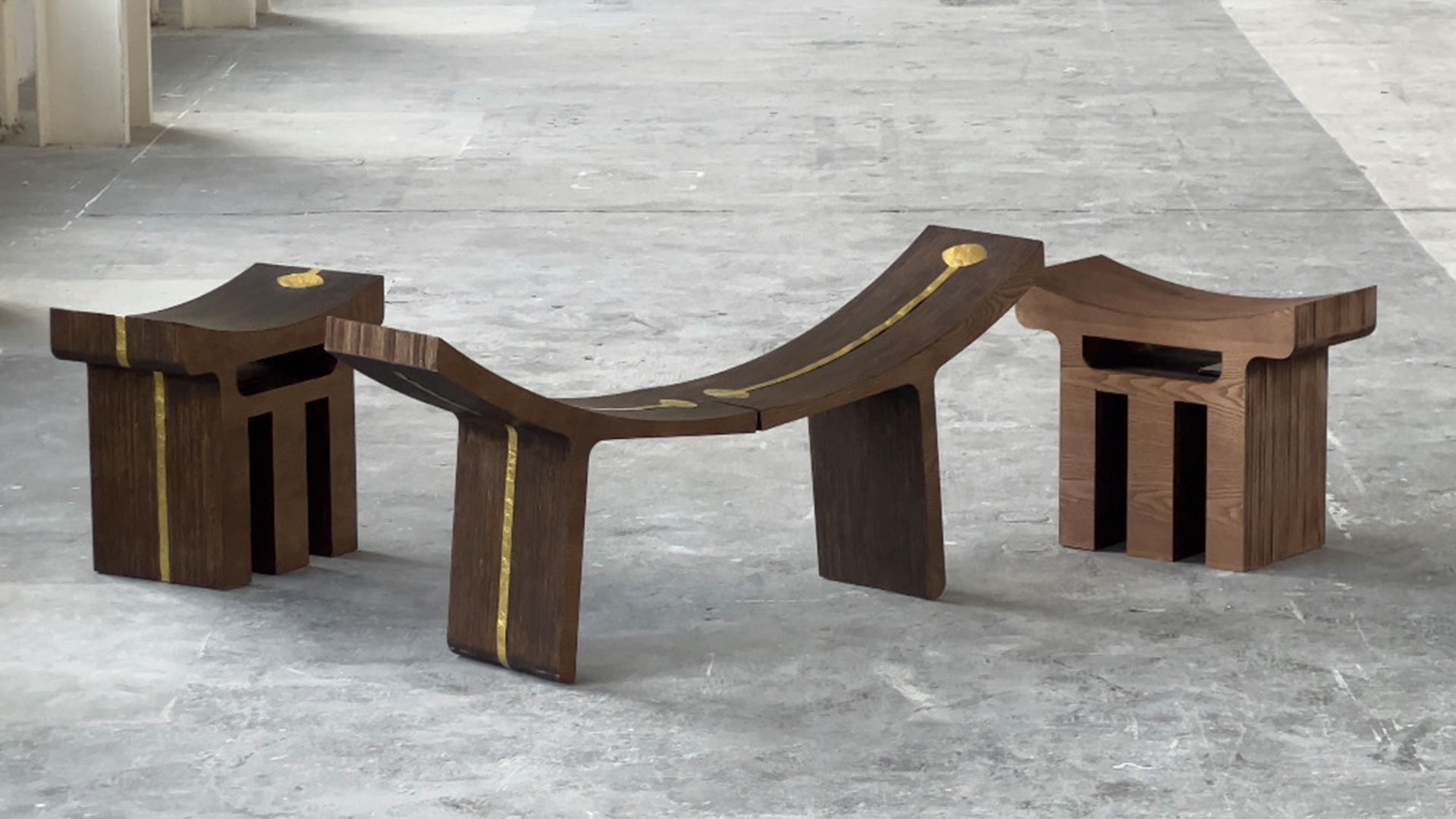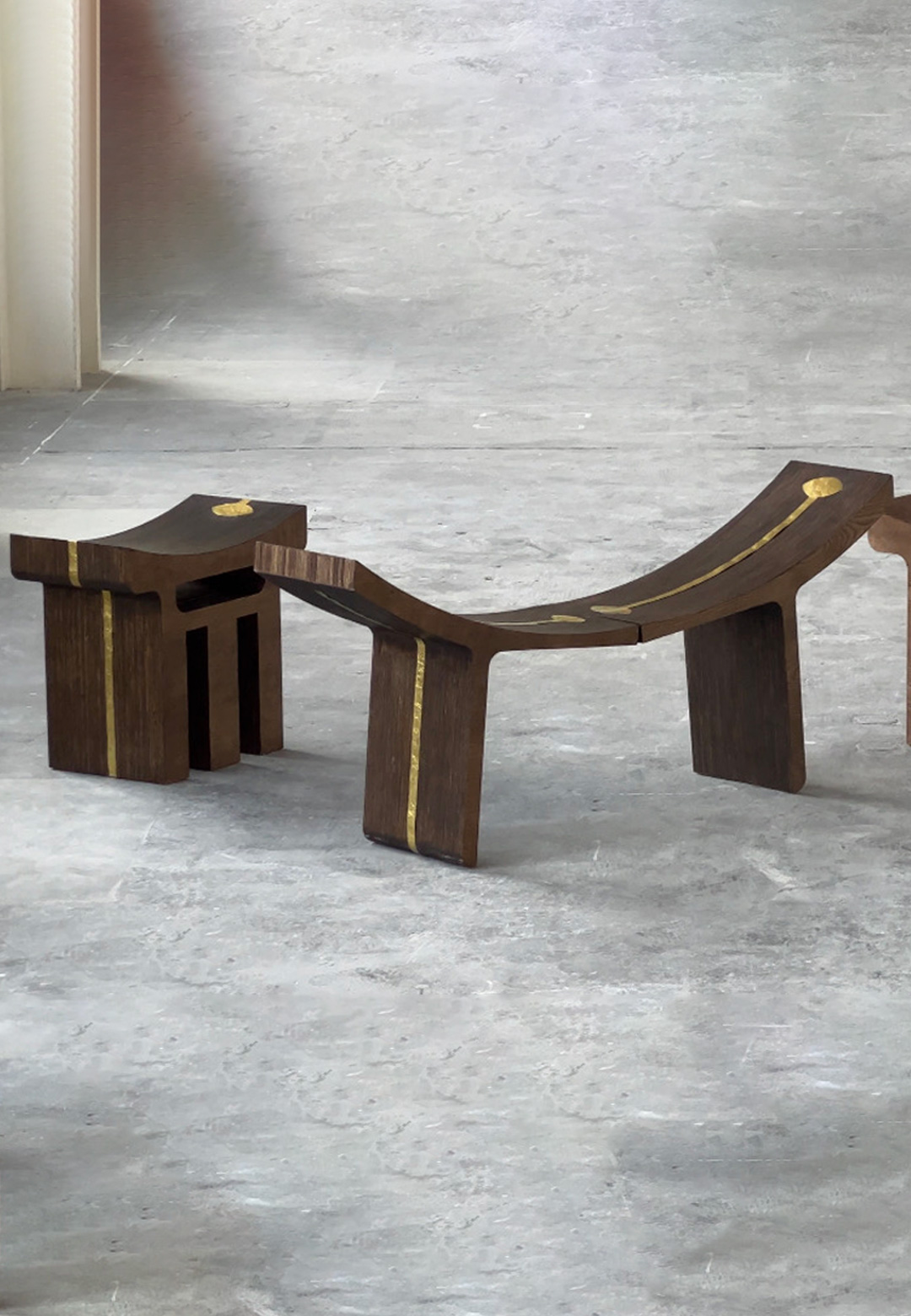Are the seemingly divergent languages of traditional and contemporary design interwoven after all? The emergence of craft and traditional know-how on the global design landscape is conspicuous. The creative community witnesses a pivot towards the archaic, grounded and the essential—gravitating towards its intricate simplicity. This wave of singularity comes about as a refreshing gust in a time when uniformity pervades the global canvas of art and design. One such designer striving to inject the symbolism of African design and traces of his Ethiopian roots into his contemporary interpretations is Abreham Brioschi.
Born in Ethopia and raised in Milan, Italy, Brioschi is a recently graduated product designer a unique vision to share. Since the days of his childhood, he had an affinity towards wood and frequently dove into journeys of creating arches and small objects employing what he calls "an emotional material." Morphing his passion for experimentation with furniture design into a design practice, Brioschi continues to build an oeuvre that stems from Ethiopian tradition. The essence of African design becomes the origin of his concepts encompassing contemporary and futuristic silhouettes. "I believe that many of the innovations we have today were born in Africa, and I think it is appropriate to link innovative forms to a design that is purely related to tradition and thus to the history of African people," the furniture designer says. On the occasion of Milan Design Week 2023, Brioschi unveiled his latest body of work dubbed Burgui Collection—a furniture ensemble that extends on Ethiopia's historical and cultural authenticity.
In a conversation with STIR, Brioschi articulates the thoughts that fuel his ethos, his perception of contemporary and traditional design and how the two melt into each other in unpredictably and harmoniously.
Anushka Sharma: How would you best describe your design philosophy?
Abreham Brioschi: Design is what connects me the most to my origins. My aim is to give importance to traditional and cultural details that are disappearing. Design isn’t something complicated and hard to understand, it starts from the earth, from people, from places, from perspectives. When I create, I just trust my intuition. What comes next is just the result of the experiences I have had. In African design the approach is radical, rougher. Every piece has an inner soul, it is made with cure and raw materials which make me feel closer to the earth.
My philosophy starts where my inspiration and my product start, the only thing I am certain of is that I will never betray my ideas. I want to inspire people and make them participate emotionally in what I do. Every product has its own emotionality and my goal is to communicate it, just like the most spectacular works of art do.
Anushka: You specialise in African inspired modern furniture. What according to you are the similarities between African design and the more contemporary language, and what sets them apart?
Abreham: In African design, the sense of community and the concept of humanity are very strong and relevant. In fact, the suggestions that this design refers to is of a design that is extremely linked to relationships, to functionality but above all to need. It is a design that seeks to unite and not singularise elements; contemporary African design is a necessary hybridisation of what has just been described and the more contemporary figures.
If for the African one, as mentioned, the end is the need, for the contemporary language the end is aesthetics, outer harmony. What can amalgamate the two languages are the use of unique materials for the works and the attention to waste. This logic and mindset has always distinguished African object creation since many tools or objects made are constructed from poor and essential materials. I think there are many commonalities between the two languages but that we designers still need to discover them. Digging into the culture and tradition of people and trying to hybridise the various pillars to a new world is never easy.
Anushka: You presented at the Divercity Festival during your graduation, and this year, at Base Milano for Salone Satellite. How has your design expression evolved from then to now?
Abreham: The first year I exhibited at the design week was a really formative experience because it gave me the opportunity to get to know many people in the design sector and to engage with their ideas and projects. From that moment on, I took a lot of responsibility for the my chair designs, which were no longer a thesis project but finally became my full time job. I deepened into the simplification and use of materials and their approach. I studied the various manufacturing methods and technological tools for seat production. My expression of design is always evolving, it is maturing and I feel more and more confident of my decisions.
Anushka: Please take us through the conceptualisation of the Burgui Collection. What inspired its inception?
Abreham: The Burgui collection stems from the desire to connect Ethiopia's historical and cultural authenticity and the technological present, with an eye to the forms of the future. Wood is the protagonist of the collection; it bears witness to African sculptural art and continues to be the main material for the creation of products whose vision is linked to 'ethical-social design.’ The curved forms that make up the Chénfer seat refer to the lip discs used by the women of the Morsi tribes in southern Ethiopia, a symbol of beauty and female pride. Leafleté seat was created inspired by traditional Ethiopian headrests: wooden objects used to safeguard hair during sleep. It has a symbolic, social and personal value. The collection’s aim is to communicate the vision of African design, which is essential but charged with symbolic content and identity. I am trying to offer a new and innovative look at it.
Anushka: Your work features a dialogue of tradition and the contemporary. Are there specific bodies of work you look up to or draw inspiration from?
Abreham: I take my inspiration from the mundane moments in life. For example when I am on one of Milan's historic trams, Carrelli 1504, I love noticing the grain of the glossy lacquered wood contrasting with the buildings and their materials that characterise the city of Milan—steel, cement and glass. The contrast between old and new that I see and observe in my daily life is what I draw most of my inspiration from. I find it trivial to be inspired by existing furniture designs, I want to try and endeavour to find my own vision. After all, the world is made of shapes, curves and materials. That is why I always travel around with my red sketchbook; I never know what MIlan’s streets will teach me and I always want to be ready to take notes.
Lately, I am attracted to architect David Adjaye's methodology of approach, "architecture as a tool to enhance communities and cultivate a symbiotic relationship between humanity and the built environment.”
Anushka: African sculptural art that fuels your design is extremely detailed and intricate. Contemporary design, on the other hand, speaks more of clean geometry and neutrality. How do you achieve harmony in these contrasts?
Abreham: To my eyes, African design also has its own harmony, and I try to pass it on through my seatings. And I do it on a technical level through tools and technologies that are part of, and mostly used for, contemporary design works. There is a word that has always fascinated me: essential. From African design works I try to capture what is really essential and necessary for the functionality of the object.
The objects I draw inspiration from are extremely simple shapes and I try to revisit them while always maintaining the basic geometries. After I finish my sketch, I eliminate all the aesthetic pretensions typical of the contemporary world. I reduce everything to the simplicity of form and the functionality of the object.
Anushka: Symbology is intrinsic to your designs such as Chenfér Seat that takes cues from labial discs used by the women of Morsi tribes and Lefleté emulating a traditional Ethiopian headrest. Did you face any challenges while achieving functionality in the furniture?
Abreham: Yes, the complexity of my design lies in the construction process. I had to redesign various elements of both seats in the collection multiple times—both for reasons of statics and weight relief, as well as for functionality. I never wanted to give up the basic forms I am inspired by, so the design process is inevitably longer and more complicated. But it is worth it because once the seat is finalised, it also turns out to be visually precise. This is an aspect I like about my seats—the careful study of the forms in addition to the design.
Anushka: The world of design is experiencing a revival of craftsmanship and traditional design in contemporary design. Do you think this juxtaposition is NEXT for the design community?
Abreham: My parents had a house in the country and I was always in the garden making objects with every kind of material I could find. That is where I discovered the beauty and practicality of wood. I think there is a kind of energy that the craftsman transmits to the various works, and that energy is retained by the object, something special that technology and machines cannot do. For the design community, I find this rediscovery to be very positive. In addition to the greater emotionality of the product, there is also a much more intimate relationship between the object and the designer. This closeness with the designer and the workforce in my opinion kindles visions that with the distance given by technology would not be possible.
Anushka: What considerations do you make while choosing materials and production techniques for your designs?
Abreham: The considerations I make for the use of materials start from the bottom of my design vision. Wood is the protagonist of all the collections I’ve done—it bears witness to the art of African sculpture and continues as the main material for the realisation of products whose vision is linked to ‘ethical-social design.’ It is a material that is easily salvageable especially in regions like northern Italy, so there is also a lot of availability compared to other materials. Another material I love to include in my seating is marble. It makes the designs very elegant and refined—that touch of luxury that together with wood makes the seating spectacular. Regarding production techniques, hand to hand with my philosophy, I prefer handcrafted techniques but with the use of machinery and advanced technology for the more complex cuts. Nowadays I think it is necessary to use machinery for the production of complex seats but in any case I will always trust the know-how of a good craftsman.
Anushka: Sustainability has become a significant aspect that needs to be addressed across different fields. How do you achieve designs that express that consciousness towards the environment?
Abreham: Sustainability is a strong dream because it does not fit into current patterns of modernity, far removed from twentieth-century culture and fully embedded in the new way of understanding our relationship with nature. Modern thought developed from an anthropocentric idea, man was seen as the centre of the universe, the master, he shaped the planet according to his needs and desires. We as designers, but especially as human beings, are responsible for the planet. This means redesigning, rethinking and remodelling the way we experience certain aspects on a daily basis.
Anushka: What is NEXT in store for you?
Abreham: I am a person who lives in the here and now. I still have a world to discover, between technical possibilities and utilisation of materials, I am very determined and have a lot of ideas in my head that I can't wait to share. My primary goal is to develop collaborations with designers and Italian companies that I have always been in love with.






 Sign in with email
Sign in with email










What do you think?